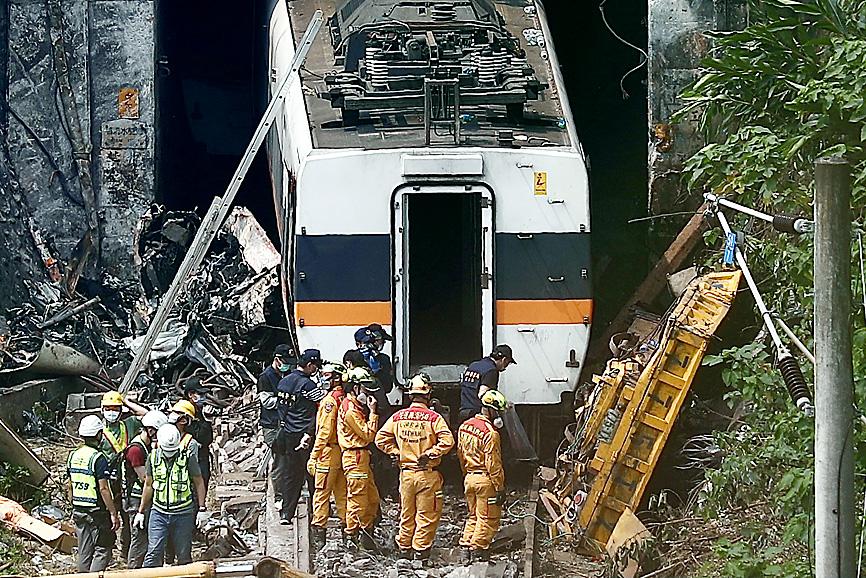A Red Cross Society rescuer on Friday recalled the scene of a train crash in Hualien County, saying he could not believe what he saw: scattered body parts and the sounds of people crying in a crumpled train carriage.
“It was a living hell,” said Lin Chi-feng (林啟豐), who led an 11-member rescue team that was among the first to arrive at the scene at 11:03am on Friday, carrying rescue and demolition gear.
The fatal incident occurred at 9:28am when Taroko Express No. 408 crashed inside the Cingshuei Tunnel (清水隧道) after slamming into a crane truck near the tunnel’s entrance.

The truck had been parked near a construction site on a hill above the track, but slid onto the tracks, police said.
The first five carriages of the eight-car train, which was carrying nearly 500 passengers, piled up inside the narrow, single-track tunnel.
At least 51 people have been confirmed dead, official data showed.
When Lin arrived, he saw several carriages badly twisted in the tunnel, with some of them ripped apart, he said, adding that he knew he had to get into the damaged cars as soon as possible to get people out.
The twisted train cars were tilted against the tunnel’s walls, but it was the devastation inside the carriages that shocked him, he said.
“Chairs were mangled, objects were scattered all over the floor and blood was everywhere,” he said.
Inside the cars, where the power was cut, the air was stuffy and dead bodies and body parts were everywhere, Lin said.
He and other rescuers found the injured by tracking the sounds of people crying.
Although most of the injured had severe bone fractures, the rescuers were able to either carry them on their backs or in their arms, he said.
Only after all of the injured were removed from the carriages stuck in the tunnel did rescuers start pulling the dead from the wreckage, Lin said.
“It was heartbreaking to see so many children and infants die in the accident,” he said.
One of the passengers, surnamed Wu (吳), who riding in the train’s second carriage, said the train went completely dark after the crash.
“About an hour later, someone guided us out of the train. When we passed through [the third carriage from the front], I couldn’t bear to look because there were bodies everywhere,” Wu said.
The driver of the train, identified as 33-year-old Yuan Chun-hsiu (袁淳修), was killed in the crash as the front car was destroyed.
Yuan had activated the emergency brake before he died, said a train conductor surnamed Lee (李).
Lee, who was in the last of the train’s eight cars, said that after the emergency brake was hit, he felt a collision that caused the carriage to shake violently.
After he exited the train, he saw many cars piled up against each other and stuck in the tunnel.
Firefighters at the scene later told him that the front car was destroyed and the driver was missing, he said.
By the time Yuan was found, he was dead, Lee said.
Many colleagues were saddened by Yuan’s death, said Chang Shuan-hua (張栓華), an executive member of the Taiwan Railway Labor Union.
Yuan passed the Taiwan Railways Administration’s recruitment examination in 2016 and began driving trains a year later, Chang said.
Yuan was married in 2019, Chang said, adding that he did not have children.

Starlux Airlines, Taiwan’s newest international carrier, has announced it would apply to join the Oneworld global airline alliance before the end of next year. In an investor conference on Monday, Starlux Airlines chief executive officer Glenn Chai (翟健華) said joining the alliance would help it access Taiwan. Chai said that if accepted, Starlux would work with other airlines in the alliance on flight schedules, passenger transits and frequent flyer programs. The Oneworld alliance has 13 members, including American Airlines, British Airways, Cathay Pacific and Qantas, and serves more than 900 destinations in 170 territories. Joining Oneworld would also help boost

A new tropical storm formed late yesterday near Guam and is to approach closest to Taiwan on Thursday, the Central Weather Administration (CWA) said. Tropical Storm Pulasan became the 14th named storm of the year at 9:25pm yesterday, the agency said. As of 8am today, it was near Guam traveling northwest at 21kph, it said. The storm’s structure is relatively loose and conditions for strengthening are limited, WeatherRisk analyst Wu Sheng-yu (吳聖宇) said on Facebook. Its path is likely to be similar to Typhoon Bebinca, which passed north of Taiwan over Japan’s Ryukyu Islands and made landfall in Shanghai this morning, he said. However, it

Taiwan's Gold Apollo Co (金阿波羅通信) said today that the pagers used in detonations in Lebanon the day before were not made by it, but by a company called BAC which has a license to use its brand. At least nine people were killed and nearly 3,000 wounded when pagers used by Hezbollah members detonated simultaneously across Lebanon yesterday. Images of destroyed pagers analyzed by Reuters showed a format and stickers on the back that were consistent with pagers made by Gold Apollo. A senior Lebanese security source told Reuters that Hezbollah had ordered 5,000 pagers from Taiwan-based Gold Apollo. "The product was not

COLD FACTS: ‘Snow skin’ mooncakes, made with a glutinous rice skin and kept at a low temperature, have relatively few calories compared with other mooncakes Traditional mooncakes are a typical treat for many Taiwanese in the lead-up to the Mid-Autumn Festival, but a Taipei-based dietitian has urged people not to eat more than one per day and not to have them every day due to their high fat and calorie content. As mooncakes contain a lot of oil and sugar, they can have negative health effects on older people and those with diabetes, said Lai Yu-han (賴俞含), a dietitian at Taipei Hospital of the Ministry of Health and Welfare. “The maximum you can have is one mooncake a day, and do not eat them every day,” Lai